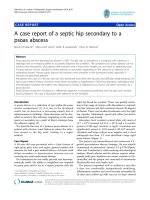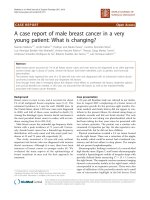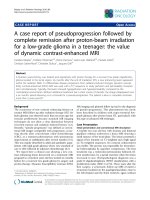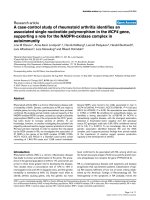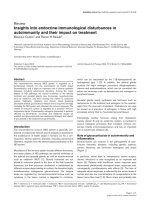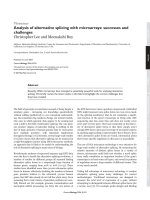Báo cáo y học: "A clay-shoveler''''s fracture with renal transplantation and osteoporosis: a case report" doc
Bạn đang xem bản rút gọn của tài liệu. Xem và tải ngay bản đầy đủ của tài liệu tại đây (238.9 KB, 4 trang )
BioMed Central
Page 1 of 4
(page number not for citation purposes)
Journal of Medical Case Reports
Open Access
Case report
A clay-shoveler's fracture with renal transplantation and
osteoporosis: a case report
Koray Unay*
1
, Omer Karatoprak
2
, Nadir Sener
3
and Korhan Ozkan
1
Address:
1
Department of Orthopedics and Traumatology, Goztepe Research and Training Hospital, Istanbul, Turkey,
2
Department of Orthopedics
and Traumatology, Kadikoy Florence Nightingale Hospital, Istanbul, Turkey and
3
Department of Orthopedics and Traumatology, Bursa Acibadem
Hospital, Bursa, Turkey
Email: Koray Unay* - ; Omer Karatoprak - ; Nadir Sener - ;
Korhan Ozkan -
* Corresponding author
Abstract
Introduction: Clay-shoveler's fracture is a rare cervicodorsal spinous process fracture and there
is little information regarding the prognosis of patients with this condition in conjunction with
osteoporosis and corticosteroid use.
Case presentation: A 39-year-old man was admitted to our institution with a 6-month history
of cervicodorsal pain prior to admission. The patient had previously undergone renal
transplantation and was on corticosteroids, and had developed osteoporosis. We treated him with
a cervical collar, non-steroidal anti-inflammatory agents and alendronate. The patient was advised
against performing weight-bearing activities for 6 months.
Conclusion: Clay-shoveler's fracture with osteoporosis and corticosteroid use presented by
fracture of the cervicodorsal aspect of the spinous processes may be successfully treated with a
collar, alendronate and long-term rest.
Introduction
Clay-shoveler's fracture is a rare condition that was first
observed at the beginning of the 20th century in non-
industrialized areas, particularly in weight-bearing work-
ers. Such fractures are rarely observed in present times
with the advent of industrialization and reduced weight-
bearing activities. Clay-shoveler's fracture is a result of the
shear forces exerted particularly by the trapezius and
rhomboid muscles on the upper and lower spinous proc-
esses of the cervical and dorsal vertebrae, respectively.
Typically, the patient complains of an acute, burning,
knife-like pain at the cervicodorsal site. Such fractures
generally respond to treatment. However, there are no
data regarding the duration of treatment or follow-up of
patients with concurrent osteoporosis [1,2].
In this case report, we discuss the treatment process and
follow-up of Clay-shoveler's fracture diagnosed late in a
bellboy with osteoporosis who had undergone renal
transplantation and was being treated with corticoster-
oids.
Case presentation
We report the case of a 39-year-old man with a height of
178 cm and weight of 72 kg, working as a bellboy in a
hotel. He had developed renal insufficiency 8 years previ-
ous, had undergone hemodialysis and had received a left
Published: 2 June 2008
Journal of Medical Case Reports 2008, 2:187 doi:10.1186/1752-1947-2-187
Received: 28 November 2007
Accepted: 2 June 2008
This article is available from: />© 2008 Unay et al; licensee BioMed Central Ltd.
This is an Open Access article distributed under the terms of the Creative Commons Attribution License ( />),
which permits unrestricted use, distribution, and reproduction in any medium, provided the original work is properly cited.
Journal of Medical Case Reports 2008, 2:187 />Page 2 of 4
(page number not for citation purposes)
renal transplantation after 2.5 years of hemodialysis. The
patient had taken 8 mg methylprednisolone once a day
for 3.5 years following the renal transplantation. The
nephrologist following-up our patient decreased the
methylprednisolone dose to 4 mg 1 week before admis-
sion.
The patient had complained of increasing back and neck
pain for 6 months prior to admission. He had been diag-
nosed with paravertebral spasm at two different locations.
There was no history of trauma. After admission, the
patient showed no improvement, and experienced wors-
ening pain. The pain was an acute shooting pain resem-
bling an electrical flash at the cervicodorsal site. Weight
bearing was an occupational requirement, and the patient
claimed that there was more pain while bearing heavy
weights. There was also a history of night pains at the cer-
vicodorsal site and pain and paresthesia of the upper
extremity and chest.
Neurological examination was normal. There was pain at
the cervicodorsal site during neck movements, particu-
larly during neck flexion. Based on the suspicious images
of the spinous processes of the C7 and D1 vertebrae in the
X-rays of the cervical and dorsal vertebrae (Figure 1), cer-
vicodorsal computerized tomography was performed
(Figure 2). The spinous process fractures of the C7, D1
and D2 vertebrae were diagnosed as Clay-shoveler's frac-
tures. The patient was treated with a cervical collar for 1.5
months. Due to the patient's history of renal transplanta-
tion and corticosteroid use, whole body bone densitome-
try was performed. The mean lumbar spine T-score was -
2.7, and the mean femoral neck T-score was -2.1. The
patient was given 10 mg oral alendronate once a day. At
the second month of follow-up, the control dual energy X-
ray absorptiometry (DEXA) value of the mean lumbar
spine T-score regressed to -2.6 and the mean femoral neck
T-score regressed to -2.0, and at the fourth month, the
scores had regressed to -2.4 and -1.9. Following the collar
and alendronate treatment, the patient's pain regressed
rapidly in 1.5 months. The patient was followed-up for 12
months, and he continued on oral methylprednisolone 4
mg/day during the follow-up.
Alendronate treatment was discontinued when the
patient's T-scores reached -2.0 (the mean lumbar spine T-
score) and -1.3 (the mean femoral neck T-score) on the
12-month DEXA scan. For evaluation of the patient's renal
function, urinary creatinine clearance was measured at 1,
2, 3, 6, 9, and 12 months after the alendronate treatment.
No renal malfunction was observed. He was given a rest
report that prohibited him from weight-bearing activities
for a total of 6 months. Control computerized tomogra-
phy scanning was performed 6 months after the resolu-
tion of the pain (Figure 3) and the fracture sites were
evaluated for union of the fractures. There was no pain at
the follow-up examination 24 months after the fracture.
Discussion
Clay-shoveler's fracture may occur through direct trauma
on the flexed spine or through shear forces; shear forces
seem to have been the cause in this case. Cases of Clay-
shoveler's fracture have been reported in the literature;
however, these cases were in otherwise healthy individu-
als with no history of prior disease. We present the case of
a bellboy with a history of renal transplantation, long-
term corticosteroid use and osteoporosis. In such patients,
it is important to be cautious with regard to renal func-
tion. Thus, while following-up our patient during alendr-
onate treatment, we also followed-up for creatinine
clearance [3,4]. He was unable to change his job and thus
needed to continue his weight-bearing activities. Rest was
discontinued on the complete resolution of the pain 12
months after the fracture, when the patient's response to
light weight-bearing exercises improved. Hence, we
ensured complete healing by advising long-term rest. The
patient was followed-up for 12 months after resuming
work, and he experienced no further symptoms. This case
indicates that it is not possible for a patient with oste-
oporosis and Clay-shoveler's fracture to bear weight
within 12 months of the fracture.
These injuries are known to be stable but painful. In most
patients, immobilization of the neck with a cervical collar
and restriction of physical activity for 4 to 6 weeks fre-
quently result in pain relief, but healing of the fractures
does not usually occur [5,6]. Our patient experienced a
X-ray of the cervicodorsal site, lateral viewFigure 1
X-ray of the cervicodorsal site, lateral view. White
arrow shows fractured spinous processes.
Journal of Medical Case Reports 2008, 2:187 />Page 3 of 4
(page number not for citation purposes)
decrease in pain with treatment, which consisted of wear-
ing a cervical collar, medication with alendronate and
weight-bearing restrictions beginning on admission 6
months after the fracture. During the 1.5 months of collar
treatment, the patient reported that his pain increased
rapidly on occasions when he did not use the collar. The
restriction of neck flexion by the collar was an important
factor in decreasing the pain, by reducing the tension of
the posterior elements at the cervicodorsal site.
Conclusion
This case demonstrated a specific painful site and a rele-
vant occupational history; it is important not to overlook
such factors in a clinical setting. Our patient's history
included osteoporosis, renal transplantation and corticos-
Control computerized tomography scan at 12 months showing axial section of the first dorsal vertebraFigure 3
Control computerized tomography scan at 12 months showing axial section of the first dorsal vertebra.
Computerized tomography scans showing axial section of the first dorsal vertebraFigure 2
Computerized tomography scans showing axial section of the first dorsal vertebra.
Publish with BioMed Central and every
scientist can read your work free of charge
"BioMed Central will be the most significant development for
disseminating the results of biomedical research in our lifetime."
Sir Paul Nurse, Cancer Research UK
Your research papers will be:
available free of charge to the entire biomedical community
peer reviewed and published immediately upon acceptance
cited in PubMed and archived on PubMed Central
yours — you keep the copyright
Submit your manuscript here:
/>BioMedcentral
Journal of Medical Case Reports 2008, 2:187 />Page 4 of 4
(page number not for citation purposes)
teroid treatment; he earned and continues to earn his live-
lihood by bearing weight, and presented with Clay-
shoveler's fracture by fracture of the cervicodorsal aspect
of the spinous processes. This was successfully treated
with a cervical collar, alendronate and long-term rest, to
the extent that the patient was able to resume weight-bear-
ing activities approximately 12 months after the fracture.
There was no pain at the follow-up examination 24
months after the fracture.
Abbreviations
DEXA: dual energy X-ray absorptiometry.
Competing interests
The authors declare that they have no competing interests.
Consent
Written informed consent was obtained from the patient
for publication of this case report and accompanying
images. A copy of the written consent is available for
review by the Editor-in-Chief of this journal.
Authors' contributions
KU contributed to conception and design of the report,
and carried out the literature search, manuscript prepara-
tion and manuscript review, OK and NS were involved in
the literature review and helped draft part of the manu-
script, KO contributed to conception and design of the
report. All authors read and approved the final manu-
script.
References
1. Cancelmo JJ: Clay-shoveler's fracture. A helpful diagnostic
sign. Am J Roentgenol Radium Ther Nucl Med 1972, 115:540-543.
2. Graber MA, Kathol M: Cervical spine radiographs in the trauma
patient. Am Fam Physician 1999, 59:331-342.
3. Parker CR, Freemont AJ, Blackwell PJ, Grainge MJ, Hosking DJ:
Cross-sectional analysis of renal transplantation osteoporo-
sis. J Bone Miner Res 1999, 14:1943-1951.
4. Sperschneider H, Stein G: Bone disease after renal transplanta-
tion. Nephrol Dial Transplant 2003, 18:874-877.
5. Okten AI, Yuksel M, Kaptanoglu E, Gul B, Evliyaoglu C: The fracture
of the lower cervical spinous process: clay shoveler's frac-
ture. Ulus Travma Dergisi 1996, 2:30-32.
6. Solaroglu I, Kaptanoglu E, Okutan O, Beskonakli E: Multiple iso-
lated spinous process fracture (clay-shoveler's fracture) of
cervical spine: a case report. Ulus Travma Acil Cerrahi Derg 2007,
13:162-164.


